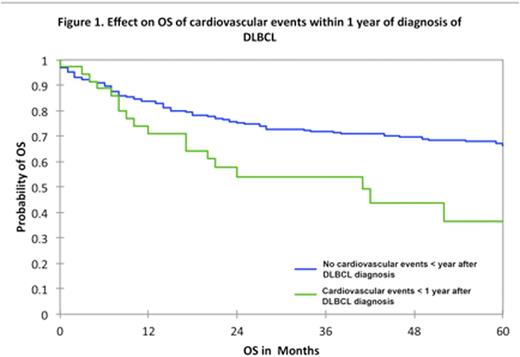Abstract
Diffuse large B cell lymphoma (DLBCL) is the most frequent non-Hodgkin lymphoma, with increasing incidence in the elderly population. Anthracycline-containing chemo immunotherapy can achieve high response rates and improved survival, but can result in cardiovascular toxicity, which can negatively affect short and long term survival, particularly in older patients. We conducted a retrospective analysis to determine the incidence of cardiovascular events after DLBCL and the effect these complications have on outcomes.
Methods: The Hematologic Malignancies Database of University Hospitals Seidman Cancer Center was accessed to identify newly diagnosed DLBCL patients between 2002 and 2014. Data on patient characteristics including cardiovascular risk factors, disease characteristics, baseline cardiac function, treatment details, and outcomes including response, relapse and cardiovascular events was collected. Univariate Cox proportional hazards analysis was conducted on risk factors and those reaching statistical significance (p < 0.05) were selected for inclusion in multivariate proportional hazards model to help identify predictors for cardiovascular events. Cumulative incidence (with death as competing risk) was used to estimate the incidence of cardiovascular events. Overall survival (OS) and progression free survival (PFS) was calculated using the Kaplan-Meier method, and comparison between groups was done with the log rank test.
Results: Four hundred DLBCL patients were included for analysis. Median age at diagnosis was 63 years, with 139 patients above the age of 70. 237 patients (59.3 %) had advanced disease (Ann Arbor stage III/IV) at diagnosis and 28 (7 %) patients had left ventricular ejection fraction less than 50 % at baseline. Other baseline characteristics are listed in Table 1. Treatment included an anthracycline-based regimen in 319 (86.3%) patients and 338 (92%) patients received rituximab. 274 (81%) patients achieved complete remission and 39 (11.5%) patients had progressive disease.
After a median follow up of 33 months, 190 patients had relapsed and 140 died. The overall 3-year PFS for the cohort was 57.6 % (95 % CI 52.4- 62.7 %) and 3-year OS 69.8 % (95 % CI 65-74.7%). Seventy four patients developed cardiovascular events, with 1-year and 3-year cumulative incidence of 9.7% (95 % CI 7.1-13.2) and 14.7 % (95 % CI 11.5 -18.9), respectively. Fifty-two patients (13 %) developed congestive heart failure, nine (2.25 %) were diagnosed with new coronary artery disease requiring revascularization and six patients (1.5 %) suffered new cerebrovascular accident. Table 2 summarizes the results of Cox proportional hazards analysis. Univariate analysis showed age > 60 years, previous history of congestive heart failure, coronary artery disease, arterial hypertension, COPD, chronic renal failure and BMI > 30 were significantly associated with cardiovascular events (p<0.05). In multivariate analysis, only age > 60 years, BMI >30 and history of chronic renal failure showed statistical significance (p = 0.016, 0.002, 0.031 respectively). Patients who presented a cardiovascular event less than 1 year after DLBCL diagnosis had an estimated 3-year OS of 49.2% (95 % CI 31-67.5 %) vs. 71.7% (95 % CI 66.8-76.6 %) in patients who did not experience early cardiovascular events (p=0.002) (Figure 1).
Conclusions. DLBCL patients have an elevated incidence of cardiovascular events after diagnosis. Most cardiac complications occur early, within 1 year of diagnosis and treatment, and have a significant effect on long-term survival. Identification of the patients at highest risk is important for guiding risk-adapted monitoring, preventive measures and early intervention. In addition to known history of cardiac disease, we identified advanced age, increased BMI and history of chronic renal failure as additional risk factors that should be incorporated in cardiac risk stratification of patients receiving therapy for DLBCL.
Caimi:Roche: Research Funding; Gilead: Consultancy; Genentech: Speakers Bureau; Novartis: Consultancy.
Author notes
Asterisk with author names denotes non-ASH members.




